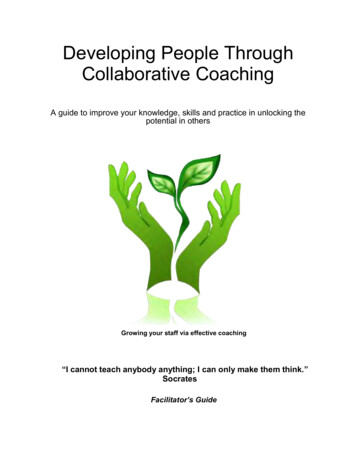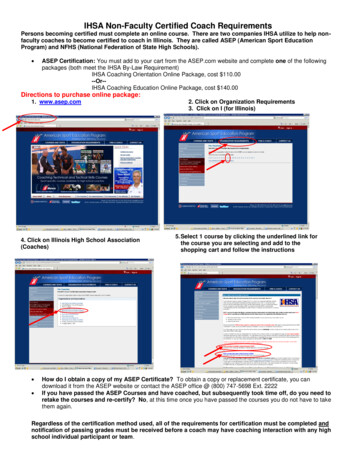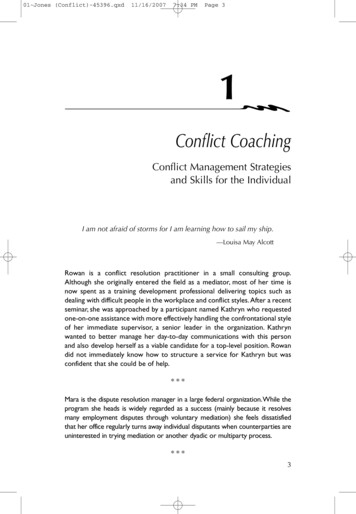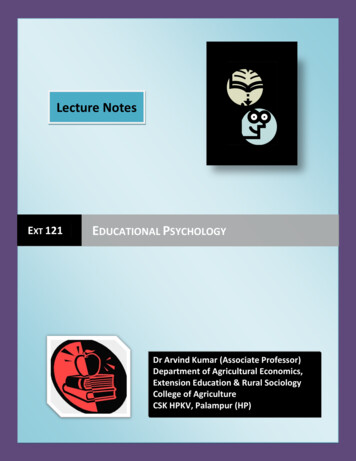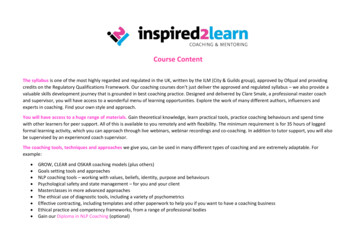
Transcription
Copyright 2019 by PositivePsychology.com All rights reserved.This ebook or any portion thereof may not be reproduced, relabeled, or used in any commercial mannerwhatsoever without the express written permission of the publisher.Permission is not required for personal or professional use, such as in a coaching or classroom setting.PositivePsychology.comGandhiplein 166229HN MaastrichtThe Netherlandshttps://PositivePsychology.com
Client Manual2 POSITIVE PSYCHOLOGY COACHINGTABLE OF CONTENTSINTRODUCTION03SESSION 1 - VALUES AND GOAL SETTING04SESSION 2 - STRENGTHS17SESSION 3 - BEHAVIORAL CHANGE24SESSION 4 - OBSTACLES AND COPING27SESSION 5 - POSITIVE EMOTIONS36SESSION 6 - EVALUATION AND THE FUTURE42
Client ManualPOSITIVE PSYCHOLOGY COACHINGINTRODUCTIONWelcome to this intervention. The upcoming sessions all share one purpose: to help youmove closer to your personal goals and increase your well-being. In order to do so, weadopt a positive focus. Rather than merely focusing on what is wrong and what preventsyou from reaching your goals, we will also consider your personal strengths.In this intervention, we will focus on what is most important in your life and consider all thepersonal qualities you already possess that will allow you to reach your personal goals anddeal with challenges that may arise on your journey.This manual was created to serve as a guide throughout the coaching sessions. It wasdesigned for several specific purposes: to offer a theoretical background and context for the phases of this intervention to help you remember the action steps and commitments that you agreed on to serve as a logbook for the most important insights that result from this interventionGood luck!3
1SESSION 1VALUES AND GOAL SETTING
Client ManualPOSITIVE PSYCHOLOGY COACHING5In this session, we are going to focus on the part of your life that needs most attention right now. We aregoing to find out what is most important to you in this part of your life and what is needed to move closer tothe life you want.EXERCISE 1.1 - THE WHEEL OF LIFEStep 1: Your most important life domainsIn this first exercise, we are focusing on the different domains in your life. Examples of life domains includeMoney & Finance, Career & Work, Health & Fitness, Fun & Recreation, Environment, Community, Family& Friends, Partner & Love and Growth & Learning. List the most important domains in your life and a briefdescription each below. List up to 10 life domains (you may also list fewer domains).These are the most important domains in my life:Life Domain 1:Life Domain 2:Life Domain 3:Life Domain 4:
6 POSITIVE PSYCHOLOGY COACHINGLife Domain 5:Life Domain 6:Life Domain 7:Life Domain 8:Life Domain 9:Life Domain 10:Client Manual
Client ManualPOSITIVE PSYCHOLOGY COACHINGStep 2: Entering the life domains in the Wheel of LifeNow a look at the wheel of life, displayed in the figure on the next page. Enter the names of your mostimportant life domains in the outer rim of the empty 78910995521010667
Client Manual8 POSITIVE PSYCHOLOGY COACHINGStep 3: Satisfaction rating of life domainsNow use the wheel of life to rate your level of satisfaction in the areas you have labelled on the wheel. 1means that you are not satisfied at all and 10 means you are highly satisfied. Simply highlight the line thatcorresponds with your level of satisfaction.Step 4: Connecting the linesConnect the lines to form an inner wheel. For an example, see the picture below.MONEY 10221FA10EONN VIRTME NHEALTH & ER77ITYRE82PARTNER & LOVECAIN98MUNNCE10109COMFINAFUSPIR
Client ManualPOSITIVE PSYCHOLOGY COACHINGStep 5: Setting PrioritiesNow take a look at the completed wheel. Are there ways you would want to change the shape of the innerwheel? If so, which domain(s) do you feel need(s) attention?These are the life domains that I feel need attention:What is the one domain that needs most attention right now? In other words, what is the domain that youwould like to start working on?This is the life domain that needs most attention right now:9
10 POSITIVE PSYCHOLOGY COACHINGClient ManualEXERCISE 1.2 - MY TOP 5 VALUESThe goal of this exercise is to increase awareness of what really matters to you in the life domain that youbelieve needs the most attention right now. Here we focus on so-called “values”.Values are the things we consider to be important in life. Values are our heart’s deepest desires for the waywe want to interact with the world, other people, and ourselves. They’re what we want to stand for in life,how we want to behave and what sort of person we want to be. Examples of values are: creativity, honesty,freedom, etc.Values are the answer to the questions: What’s important to you in your life? What is your life’s purpose? What do you enjoy doing? When do you feel satisfied and fulfilled?Your valuesPlease take a look at the Wheel of Life and consider the life domain you believe needs the most attentionright now.Please think of the values that are most important to you in this specific life domain.On the next page is an inventory of core values that you can just read through and see which values ringtrue for you. Just use ticks and crosses to mark off values or, if you prefer, use a rating to help you workout which are more important. Remember that no list can ever be complete. There may be some additionalpersonal values that are unique to you, so don’t be limited by the list. Just add anything else that feels right.Please select your 5 most important values in the life domain that needs most attention right now.
Client ManualPOSITIVE PSYCHOLOGY COACHINGValues list:AcceptanceAchievementAdvancement & DiscoveryDiversityEnvironmental AwarenessEconomic citementExperimentExpertiseFairnessFameFamily HappinessFast lping OthersHelping nceInfluencing OthersInner wledgeLeadershipLearningLoyaltyMagnificenceMaking a DifferenceMasteryMeaningful riginalityOrderPeacePersonal DevelopmentPersonal ationResponsibility & AccountabilityRiskSafety & illUnityVarietyWealthWinningWisdom11
12 POSITIVE PSYCHOLOGY COACHINGClient ManualOther values that are not on this list:My 5 most important values in this life domain are:Value #1Value #2Value #3Value #4Value #5EXERCISE 1.3 - MY GOALSIn the previous exercises, you identified the life domain that needs most attention and the things you findmost important in this life domain (your values). Now we are going to focus on the first step to change:finding out what exactly needs to be changed. Ask yourself the following question:What exactly do I want to change in the life domain that needs most attention?This is what I would like to change in the life domain that needs most attention:
Client ManualPOSITIVE PSYCHOLOGY COACHING13What would be needed to make this change happen? To answer this question, you may consider the valuesyou chose in exercise 1.2. Are there any values that you believe you are not (sufficiently) living in line with?What action steps would be needed to live more in line with these values?This is what is needed to make the desired change happen:
14 POSITIVE PSYCHOLOGY COACHINGTogether with your coach, set one or more goal(s) and list them below.These are my most important goals:Goal #1Goal #2Goal #3Goal #4Goal #5Client Manual
Client ManualPOSITIVE PSYCHOLOGY COACHING15NOTESUse the space below to write down notes regarding this session. For example, you may write down importantinsights, things you need to remember, etc. Feel free to use the space in a way that serves your needs.
16 POSITIVE PSYCHOLOGY COACHINGClient ManualHOMEWORKMake a visual representation of your goals and/or values (also referred to as vision board). This can bedone digitally, by selecting images, photos, words, names, etc. from the internet and combining them in aPowerPoint file, or by hand, using magazines and other resources. You can use the following three steps tocreate your own personal vision board:1. Collect images for your vision board.Find (positive) images that correspond to your chosen values and goals. Look for images that resonatewith you. Choose images that correspond with what you believe is important in life. Use the internet,magazines, and photographs as potential sources.2. Collect words for your vision board.You can decide to keep your vision board completely visual, but may also decide to add words to it.Again, make sure that the words you use are a reflection of or are related to your personal values.3. Put your vision board together.Once you’ve selected your images and inspiring phrases, get creative with your arrangement.If you feel comfortable, bring your vision board to the next session.
2SESSION 2STRENGTHS
18 POSITIVE PSYCHOLOGY COACHINGClient ManualSTRENGTHS - BACKGROUNDIn this session and the following sessions we are going to focus on your strengths. Strengths arecharacteristics of you that allow you to perform well or at your personal best. When you use your strengths,you feel energized and engaged. Examples of a strength are creativity or curiosity.Strengths can also refer to certain qualities of you that help you to effectively deal with difficult times.Examples of these characteristics include optimism (positive expectations of the future), gratitude (beingable to see the positive despite the negative) and mindfulness (being able to live in the present moment).Scientific research has consistently demonstrated that using one’s strengths is associated with higher levelsof well-being. For example, people who use their strengths have been found to experience more positiveaffect, vitality, self-esteem, job satisfaction and work engagement.
Client ManualPOSITIVE PSYCHOLOGY COACHING19NOTESUse the space below to write down notes regarding this session. For example, you may write down importantinsights, things you need to remember, etc. Feel free to use the space in a way that serves your needs.My personal notes for this session:
20 POSITIVE PSYCHOLOGY COACHINGClient ManualHOMEWORKPlease complete the VIA questionnaire online:1. Go to: hs-Survey and take the free VIA survey.2. Ask at least three other persons, preferably from different contexts (e.g. a colleague, a family memberand a friend) to assess your strengths. Use the overviews with strengths on the next pages and askthese three other persons to select 5 (not more or less) strengths that they believe characterize you.Also ask why they believe these strengths characterize you.Please bring this list to the next session.3. Become aware of your own strenghts and pay attention to positive feelings this week. Feelings like forinstance energy, excitement or gratitude. If you want, you can write down what you are doing, who iswith you, and if any strengths are at play.
Client ManualPOSITIVE PSYCHOLOGY COACHING21Please read the following descriptions of 24 positive character attributes given below. Select ONLY FIVE (no less,no more) you find characterize me best by placing a check mark in the corresponding box.Wisdom & Knowledge – strengths which involve acquiring and using knowledgeCreativity: Thinking of novel and productive ways to do thingsCuriosity: Openness to experience: Taking an interest in all of ongoing experienceOpen-mindedness: Thinking things through and examining them from all sidesLove of learning: Mastering new skills, topics, and bodies of knowledgePerspective: Being able to provide wise counsel to othersCourage – emotional strengths which involve exercise of will to accomplish goals in the face of opposition, external orinternalBravery: Not shrinking from threat, challenge, or painPersistence: Finishing what one starts, persisting in a group of actions in spite of obstaclesIntegrity: Speaking the truth and presenting oneself in a genuine wayVitality/Zest: Approaching life with excitement and energy; not doing things half-way or half-heartedly, living life as anadventure; feeling alive and activatedHumanity – interpersonal strengths that involve tending and befriending othersLove: Valuing close relations with others, in particular those in which sharing and caring are reciprocated; being close topeopleKindness: Doing favours and good deeds for others; helping them; taking care of themSocial intelligence: Being aware of the motives and feelings of self and others; knowing what to do to fit into differentsocial situations; knowing what makes other people tickJustice – strengths that underlie healthy community lifeCitizenship :Working well as member of a group or team; being loyal to the group; doing one’s shareFairness: Treating all people the same according to notions of fairness and justice; not letting personal feelings biasdecisions about others; giving everyone a fair chanceLeadership: Encouraging a group of which one is a member to get things done and at the same time maintain goodrelations within the group; organizing group activities and seeing that they happenTemperance – Strengths that protect against excessForgiveness & Mercy: Forgiving those who have done wrong; accepting the shortcomings of others; giving people asecond chance; not being vengefulHumility/Modesty: Letting one’s accomplishments speak for themselves; not seeking the spotlight; not regardingoneself as more special than one isPrudence: Being careful about one’s choices; not taking undue risks; not saying or doing things that might later beregrettedSelf-regulation [self-control]: Regulating what one feels and does; being disciplined; controlling one’s appetites andemotionsTranscendence – Strengths that forge connections to the larger universe and provide meaningAppreciation of beauty and excellence: Noticing and appreciating beauty, excellence, and/or skilled performance in alldomains of life, from nature to arts to mathematics to science.Gratitude: Being aware of and thankful for the good things; taking time to express thanksHope/Optimism: Expecting the best in the future and working to achieve it; believing that a good future is somethingthat can be brought aboutHumour/Playfulness: Liking to laugh and tease; bringing smiles to other people, seeing the light side; making (notnecessarily telling) jokesSpirituality: Knowing where one fits within the larger scheme; having coherent beliefs about the higher purpose andmeaning of life that shape conduct and provide comfort
22 POSITIVE PSYCHOLOGY COACHINGClient ManualPlease read the following descriptions of 24 positive character attributes given below. Select ONLY FIVE (no less,no more) you find characterize me best by placing a check mark in the corresponding box.Wisdom & Knowledge – strengths which involve acquiring and using knowledgeCreativity: Thinking of novel and productive ways to do thingsCuriosity: Openness to experience: Taking an interest in all of ongoing experienceOpen-mindedness: Thinking things through and examining them from all sidesLove of learning: Mastering new skills, topics, and bodies of knowledgePerspective: Being able to provide wise counsel to othersCourage – emotional strengths which involve exercise of will to accomplish goals in the face of opposition, external orinternalBravery: Not shrinking from threat, challenge, or painPersistence: Finishing what one starts, persisting in a group of actions in spite of obstaclesIntegrity: Speaking the truth and presenting oneself in a genuine wayVitality/Zest: Approaching life with excitement and energy; not doing things half-way or half-heartedly, living life as anadventure; feeling alive and activatedHumanity – interpersonal strengths that involve tending and befriending othersLove: Valuing close relations with others, in particular those in which sharing and caring are reciprocated; being close topeopleKindness: Doing favours and good deeds for others; helping them; taking care of themSocial intelligence: Being aware of the motives and feelings of self and others; knowing what to do to fit into differentsocial situations; knowing what makes other people tickJustice – strengths that underlie healthy community lifeCitizenship :Working well as member of a group or team; being loyal to the group; doing one’s shareFairness: Treating all people the same according to notions of fairness and justice; not letting personal feelings biasdecisions about others; giving everyone a fair chanceLeadership: Encouraging a group of which one is a member to get things done and at the same time maintain goodrelations within the group; organizing group activities and seeing that they happenTemperance – Strengths that protect against excessForgiveness & Mercy: Forgiving those who have done wrong; accepting the shortcomings of others; giving people asecond chance; not being vengefulHumility/Modesty: Letting one’s accomplishments speak for themselves; not seeking the spotlight; not regardingoneself as more special than one isPrudence: Being careful about one’s choices; not taking undue risks; not saying or doing things that might later beregrettedSelf-regulation [self-control]: Regulating what one feels and does; being disciplined; controlling one’s appetites andemotionsTranscendence – Strengths that forge connections to the larger universe and provide meaningAppreciation of beauty and excellence: Noticing and appreciating beauty, excellence, and/or skilled performance in alldomains of life, from nature to arts to mathematics to science.Gratitude: Being aware of and thankful for the good things; taking time to express thanksHope/Optimism: Expecting the best in the future and working to achieve it; believing that a good future is somethingthat can be brought aboutHumour/Playfulness: Liking to laugh and tease; bringing smiles to other people, seeing the light side; making (notnecessarily telling) jokesSpirituality: Knowing where one fits within the larger scheme; having coherent beliefs about the higher purpose andmeaning of life that shape conduct and provide comfort
Client ManualPOSITIVE PSYCHOLOGY COACHING23Please read the following descriptions of 24 positive character attributes given below. Select ONLY FIVE (no less,no more) you find characterize me best by placing a check mark in the corresponding box.Wisdom & Knowledge – strengths which involve acquiring and using knowledgeCreativity: Thinking of novel and productive ways to do thingsCuriosity: Openness to experience: Taking an interest in all of ongoing experienceOpen-mindedness: Thinking things through and examining them from all sidesLove of learning: Mastering new skills, topics, and bodies of knowledgePerspective: Being able to provide wise counsel to othersCourage – emotional strengths which involve exercise of will to accomplish goals in the face of opposition, external orinternalBravery: Not shrinking from threat, challenge, or painPersistence: Finishing what one starts, persisting in a group of actions in spite of obstaclesIntegrity: Speaking the truth and presenting oneself in a genuine wayVitality/Zest: Approaching life with excitement and energy; not doing things half-way or half-heartedly, living life as anadventure; feeling alive and activatedHumanity – interpersonal strengths that involve tending and befriending othersLove: Valuing close relations with others, in particular those in which sharing and caring are reciprocated; being close topeopleKindness: Doing favours and good deeds for others; helping them; taking care of themSocial intelligence: Being aware of the motives and feelings of self and others; knowing what to do to fit into differentsocial situations; knowing what makes other people tickJustice – strengths that underlie healthy community lifeCitizenship :Working well as member of a group or team; being loyal to the group; doing one’s shareFairness: Treating all people the same according to notions of fairness and justice; not letting personal feelings biasdecisions about others; giving everyone a fair chanceLeadership: Encouraging a group of which one is a member to get things done and at the same time maintain goodrelations within the group; organizing group activities and seeing that they happenTemperance – Strengths that protect against excessForgiveness & Mercy: Forgiving those who have done wrong; accepting the shortcomings of others; giving people asecond chance; not being vengefulHumility/Modesty: Letting one’s accomplishments speak for themselves; not seeking the spotlight; not regardingoneself as more special than one isPrudence: Being careful about one’s choices; not taking undue risks; not saying or doing things that might later beregrettedSelf-regulation [self-control]: Regulating what one feels and does; being disciplined; controlling one’s appetites andemotionsTranscendence – Strengths that forge connections to the larger universe and provide meaningAppreciation of beauty and excellence: Noticing and appreciating beauty, excellence, and/or skilled performance in alldomains of life, from nature to arts to mathematics to science.Gratitude: Being aware of and thankful for the good things; taking time to express thanksHope/Optimism: Expecting the best in the future and working to achieve it; believing that a good future is somethingthat can be brought aboutHumour/Playfulness: Liking to laugh and tease; bringing smiles to other people, seeing the light side; making (notnecessarily telling) jokesSpirituality: Knowing where one fits within the larger scheme; having coherent beliefs about the higher purpose andmeaning of life that shape conduct and provide comfort
3SESSION 3BEHAVIORAL CHANGE
Client ManualPOSITIVE PSYCHOLOGY COACHING25EXERCISE 3.1 - MY SIGNATURE STRENGTHS“Signature strengths” refer to those character strengths that are most essential to who we are. Please listyour 5 signature strengths below.My 5 Signature Strengths are:Strength #1Strength #2Strength #3Strength #4Strength #5
26 POSITIVE PSYCHOLOGY COACHINGClient ManualNOTESUse the space below to write down notes regarding this session. For example, you may write down importantinsights, things you need to remember, etc. Feel free to use the space in a way that serves your needs.My personal notes for this session:
Client ManualPOSITIVE PSYCHOLOGY COACHING27HOMEWORK1. Please list a few concrete actions for the next week that will help you to move closer to your goals.In order to move closer to my goals, I have planned the following concrete actions for next week:Action #1Action #2Action #3Action #4Action #52. For the next week, try to become aware of activities that allow you to use your strengths. You may usethe exercise “My Strength Moments” on the next page to list activities that give you energy/result inpositive experiences. Use the table to list: the date of the activity a brief description of the activity. Make sure to write down activities that you performed/accomplished,rather than your emotions or someone else’s actions (example, don’t write down “I felt happy for receiving positive feedback on my marketing presentation”) what you experienced during the activity (emotions, feelings). Try to be specific when listing yourexperience and emotions. For example: “I felt happy and accomplished after presenting my newmarketing campaign without stuttering.” or “I was feeling dreadful when I realized that I had forgottenmy sister’s birthday.” Avoid vague sentences such as: “I enjoyed going to the park with my family.” or “Ifeel bad that my sister is upset.” to which extent you enjoyed the activity the amount of energy that the activity provided
Client Manual28 POSITIVE PSYCHOLOGY COACHINGEXERCISE 3.2 MY STRENGTH ymentlevel(1-10 scale)Energy level(1-10 scale)Strength used in activity
4SESSION 4OBSTACLES AND COPING
30 POSITIVE PSYCHOLOGY COACHINGClient ManualMINDFULNESS - BACKGROUNDIn this session, you are going to explore mindfulness and acceptance. What does mindfulness mean?Mindfulness is all about attention. Attention can be directed inside ourselves as well as outside ourselves.Attention for feelings, bodily sensations, thoughts or emotions are examples of attention for the insideworld. Attention for a conversation with a friend, trees in a forest, sounds or a book are all examples ofattention for the outside world.Mindfulness is attention for the now. Attention for the things that are happening in this verymoment. This may sound easy, but how many times is our attention completely taken by thoughts?Although it is hard to deny that thinking is often very handy – we can make plans and solve difficultproblems – at the same time, it is the most important cause of many of our problems. Our mind easily getslost in endless thinking (worrying and rumination). Our thoughts create emotions and feelings like fear andstress. We lie awake at night because we worry about what might happen tomorrow. We can’t stop thinkingof that stupid mistake we made last week. In our mind, we are constantly busy with the things that need tobe completed. These are only a few examples of how our mind can make life difficult. Mindfulness teachesus by means of attention how to deal with these problematic thoughts. Mindfulness helps us to create adifferent relationship with our thoughts, feelings and emotions.Mindful attention means attention without judgment. Often, sensations like tension or fearare automatically labelled as “ bad”, “ inappropriate” or “unwanted”. When we judge a certain feeling (“Iexperience fear, this is bad, I don’t want this”) we automatically create a conflict; a conflict between thecurrent feeling (“bad”) and how the feeling should be (“good”). Attempts to solve this conflict, for instance bysuppressing the negative feeling, do not only require a lot of energy, but can paradoxically cause us to feeleven worse.Acceptance plays a key role in mindfulness. Every feeling, emotion, sensation or thought is allowedto be there. It is there anyway. Instead of fighting against feelings or thoughts, mindfulness fosterswillingness to acknowledge, allow and accept these internal states. By letting go of this struggle and fight,we not only save energy, we also experience that the things we fight against, fade away automatically;often even sooner than when we actively fight against them. As soon as an emotion receives room tobe there, one can experience that the emotion is only temporary; she comes and goes. In this way, onebecomes an observer of one’s own inner states. One is no longer identified and completely lost in thecontent of thoughts and feelings, but observes them. This observer still experiences the emotion or feeling,but now has the choice of being fully taken by them or not. By observing thoughts without judgment, onecan experience their transient nature. In addition, we learn that not everything we think is true. In sum,mindfulness can help to identify less with feelings, emotions or thoughts. In other words, you are not theemotion or the thought; you are aware of an emotion or a thought.
Client ManualPOSITIVE PSYCHOLOGY COACHING31EXERCISE 4.1 - THREE-MINUTE BREATHING SPACEThe three-minute breathing space is a very brief mindfulness meditation that can help you to integratemindfulness into everyday life. It enables you to disrupt automatic patterns of thinking and behavior andincrease acceptance-based coping.The exercise involves the following three steps. The first step is asking oneself “Where am I?” “How amI?” “What am I thinking?” In this way, you can step outside the “doing mode” for a moment, and interrupthabitual patterns. This phase allows you to connect to the present moment. The second step involves asingle focus of attention. Attention is directed away from thinking and focused on the breath. During thethird and last step, attention is expanded so that it also includes awareness of body sensations. The focusis on the body as a whole. The three-minute breathing space requires willingness to experience what ispresent.During the day, pause at random or fixed moments (e.g., you can set a timer on your phone) and performthe three-minute breathing space. Take about 1 minute per phase:1. Awareness: Ask yourself the question: How am I doing right now? Focus your attention on your innerperception. Notice which thoughts, feelings and physical sensations you are experiencing. Try totranslate your experiences into words. For example: “there are self-critical thoughts” or “I notice I amtensed”. What are you feeling in your body? Allow yourself to feel what you are feeling in the currentmoment. Accept it. You can tell yourself that it’s okay what you’re feeling, and that whatever is there isfine just the way it is.2. Breathing: Focus your full attention on your breath. Follow the breathing with your attention.3. Expansion of attention: Allow your attention to expand to the rest of your body. Feel how your breathmoves throughout your whole body. With every in-breath you can feel how your body expands a littleand with each out-breath how it shrinks a little.Note
List the most important domains in your life and a brief description each below. List up to 10 life domains (you may also list fewer domains). These are the most important domains in my life: Life Domain 1: Life Domain 2: Life Domain 3: Life Domain 4: In this session, we are going to focus on the part of your life that needs most attention .

